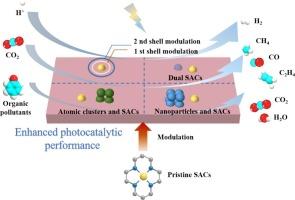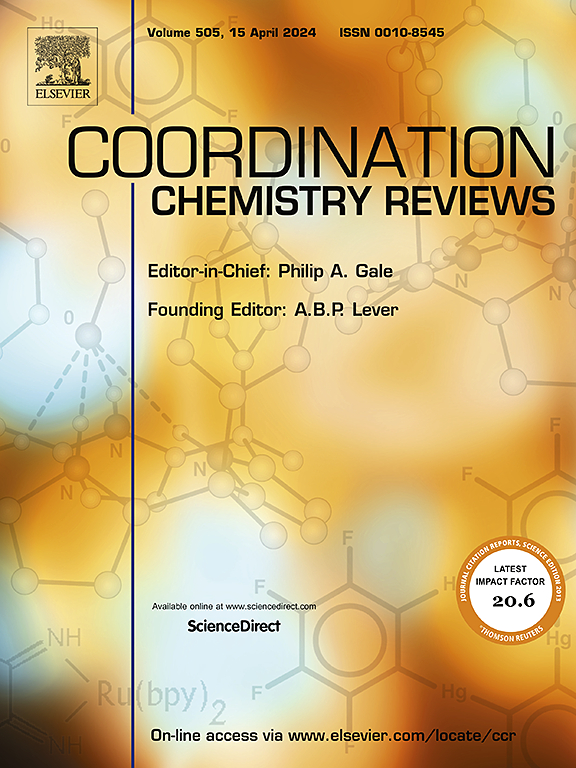高效多相光催化的单原子催化剂改性工程
IF 23.5
1区 化学
Q1 CHEMISTRY, INORGANIC & NUCLEAR
引用次数: 0
摘要
可以说,单原子催化剂已成为多相催化中最活跃的研究方向,也是一种极具发展前景的新型催化材料。其中,每个催化单元由单个金属原子及其周围的配位原子组成。这些组分的改变将调节和控制SACs的几何和电子结构,从而决定其催化活性、选择性和催化过程中的稳定性。本文首先介绍和分类了近年来发展起来的改性策略,重点介绍了如何通过可控地调整金属中心的电子结构来进一步提高性能。讨论了实验(原位/操作)和计算技术的最新表征技术,这些技术的进步使得确定SACs的动态结构演变和激活机制成为可能。然后详细讨论了改性SACs在光催化中的广泛应用,重点讨论了增强光催化活性的来源(光收集能力、电荷转移/分离动力学和表面催化反应动力学)和反应机理。最后,对改性活性炭的发展前景进行了展望,希望对今后改性活性炭在能源和环境应用方面的进一步发展有所启示。本文章由计算机程序翻译,如有差异,请以英文原文为准。


Modification engineering over single-atom catalysts for efficient heterogeneous photocatalysis
Arguably, single-atom catalysts (SACs) have become the most active research direction and a new promising catalytic material in heterogeneous catalysis. Among them, each catalytic unit consists of single metal atom and its surrounding coordination atoms. The alteration of these components will regulate and control the geometrical and electronic structures of SACs, which in turn determine its catalytic activity, selectivity and stability during catalytic processes. In this review, the recently developed modification strategies for SACs are first introduced and classified, with great attention given to how the performance can be further improved by controllably tuning the electronic configuration of the metal centers. The state-of-the-art characterization techniques of experimental (in situ/operando) and computational techniques are discussed, advances in which have made it possible to determine dynamic structural evolution and activation mechanism of SACs. A wide range of applications based on modified SACs in photocatalysis are then elaborately discussed, with attention on the sources of enhanced photocatalytic activity (light-harvesting ability, charge transfer/separation dynamics and surface catalytic reaction kinetics) and reaction mechanisms. Finally, perspectives on the development of modified SACs are provided and prospected, which is hoped to shed some light on the further development of SACs in energy and environmental applications.
求助全文
通过发布文献求助,成功后即可免费获取论文全文。
去求助
来源期刊

Coordination Chemistry Reviews
化学-无机化学与核化学
CiteScore
34.30
自引率
5.30%
发文量
457
审稿时长
54 days
期刊介绍:
Coordination Chemistry Reviews offers rapid publication of review articles on current and significant topics in coordination chemistry, encompassing organometallic, supramolecular, theoretical, and bioinorganic chemistry. It also covers catalysis, materials chemistry, and metal-organic frameworks from a coordination chemistry perspective. Reviews summarize recent developments or discuss specific techniques, welcoming contributions from both established and emerging researchers.
The journal releases special issues on timely subjects, including those featuring contributions from specific regions or conferences. Occasional full-length book articles are also featured. Additionally, special volumes cover annual reviews of main group chemistry, transition metal group chemistry, and organometallic chemistry. These comprehensive reviews are vital resources for those engaged in coordination chemistry, further establishing Coordination Chemistry Reviews as a hub for insightful surveys in inorganic and physical inorganic chemistry.
 求助内容:
求助内容: 应助结果提醒方式:
应助结果提醒方式:


